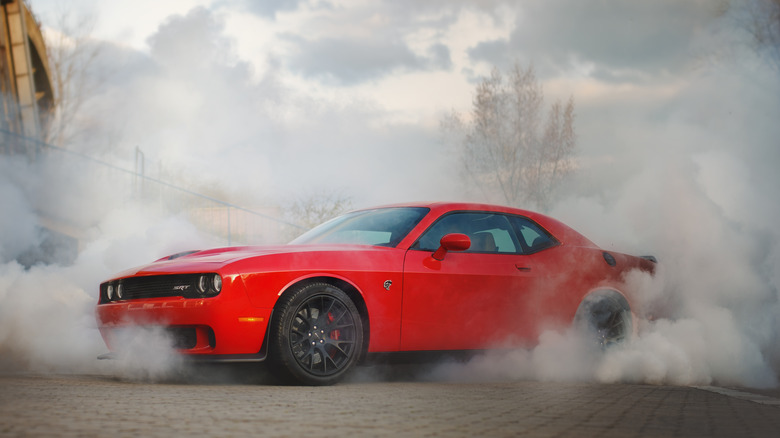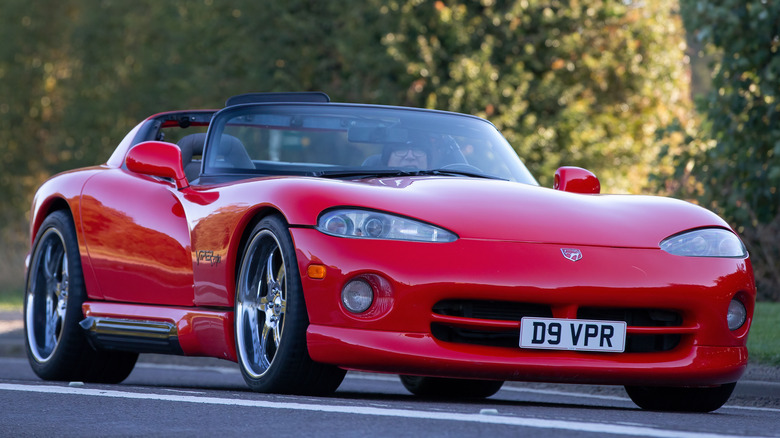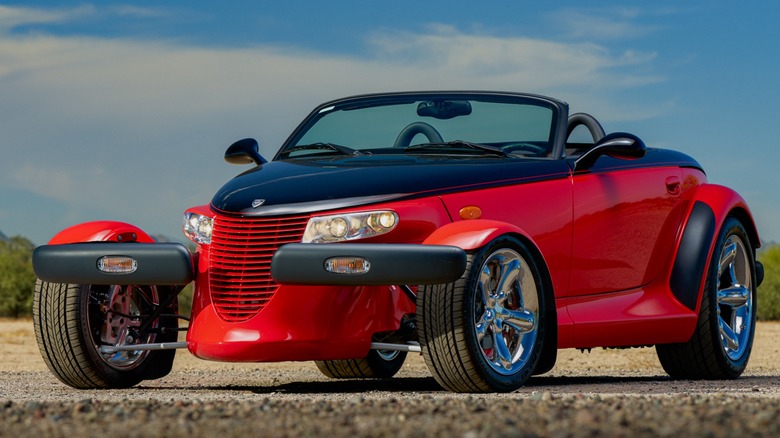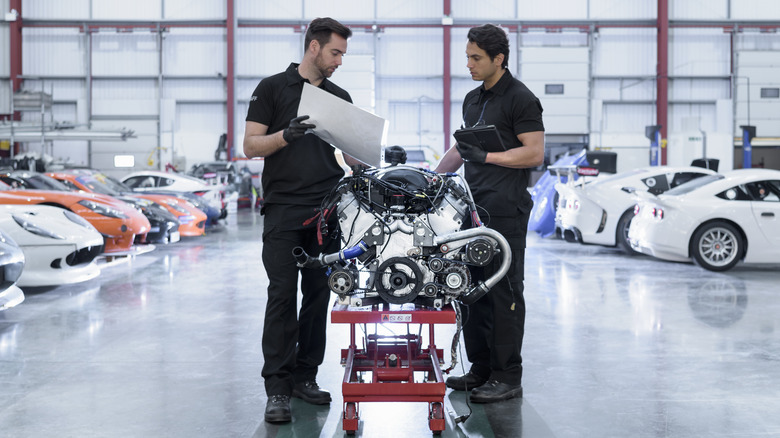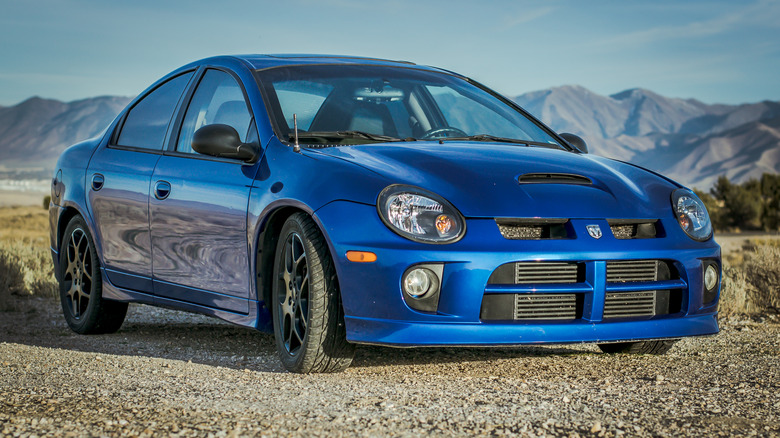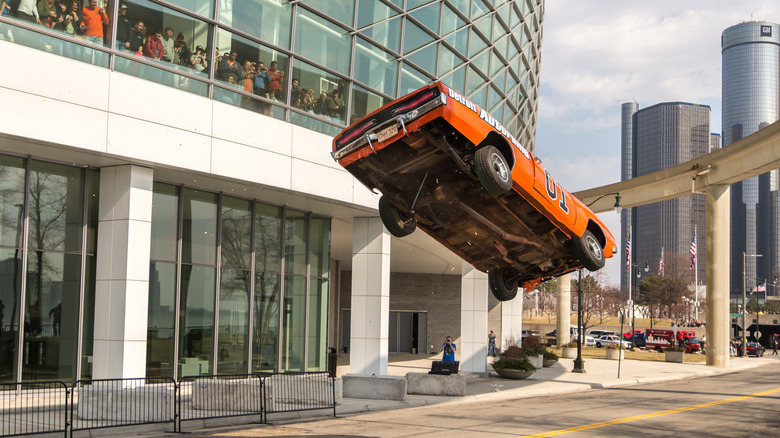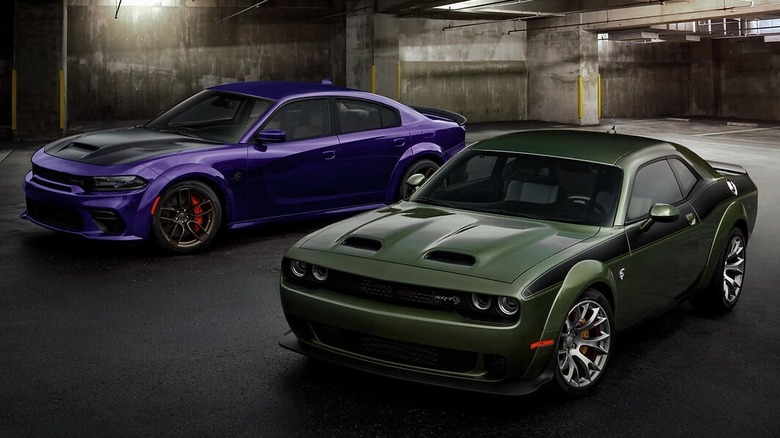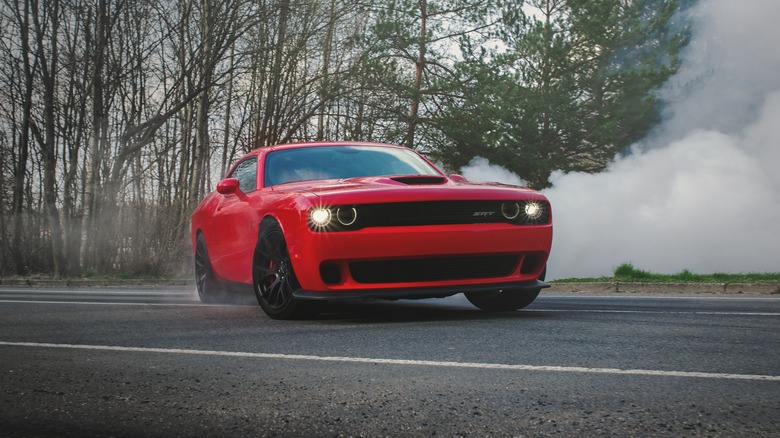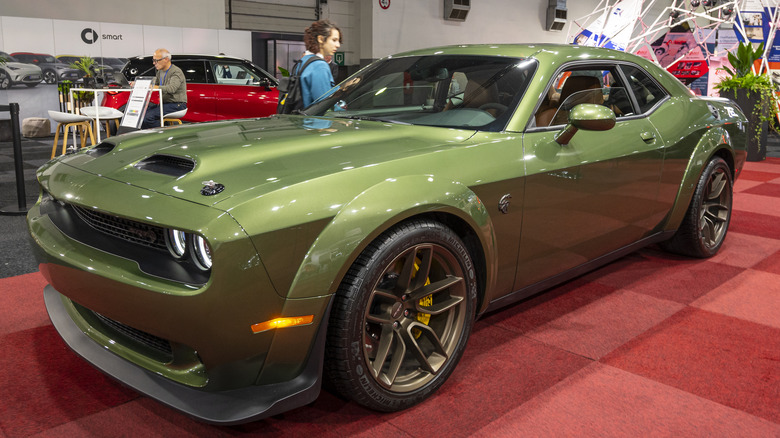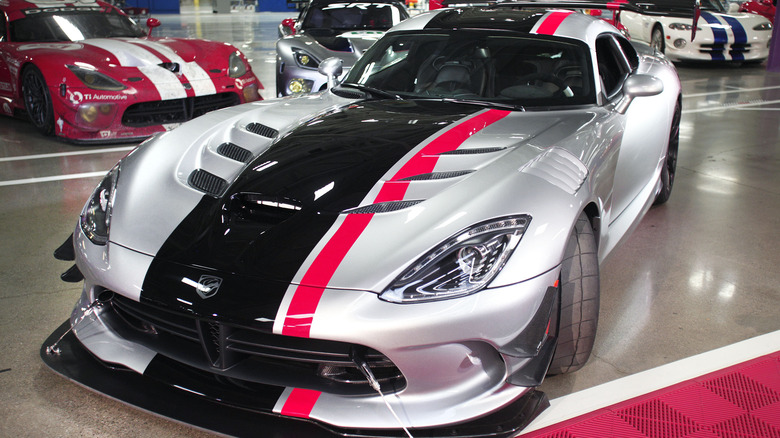Dodge SRT: The Rise And Fate Of A Performance Icon
Auto enthusiasts may note that there was no sign of the SRT in the heyday of the '60s and '70s when big block muscle cars ruled the roost. Floating in the great acronym ocean, one could find Chevrolet with Super Sport (SS), Rally Sport (RS), and Z/28, Ford with its Boss and GT (Grand Tourer) packages, Pontiac with Trans Am, and Mopar with R/T (Road/Track).
If you don't remember SRT from the muscle era, don't worry. It wasn't there. SRT stands for Street and Racing Technology, and it has been the official name of Chrysler's performance division since 2004, though its origins go back even further.
The SRT division brought us the Hellcat and Hellcat RedEye, some truly wild Dodge Vipers, and even a neat little Neon or two. It has garnered a reputation as deep and well-deserved as any muscle-era monster. With the age of the internal combustion engine (ICE) drawing to a close, what's next for the venerable performance division?
Street and Racing Technology. We've seen the acronym "SRT" on some of the most powerful vehicles of the modern era. Most of us have come to understand that the SRT marks something special, a car with a little extra to it, but there is more to the story.
Join us as we explore the history of Mopar's worst-kept secret, discover the ideas and operations behind its genesis, examine some of the fantastic automobiles it built, and imagine what the future may have in store for SRT.
Team Viper
Gas crises and environmental regulations crushed what had once been the living embodiment of no replacement for displacement: the American muscle car industry. By the early 1970s, the fun was nearly over. Remember the Mustang II? That was just the beginning.
By the late 1980s, American car manufacturing had seen better days, but the Chrysler Corporation was in potentially mortal danger until Chrysler president Bob Lutz struck on an idea while driving his Autokraft MK IV Shelby Cobra. What if Chrysler built its own Cobra, a barebones street-legal race car with a Mopar badge? The Dodge K-car and Plymouth Reliant weren't exactly known for speed or handling. If Chrysler wanted to get into the performance game, something would have to change.
Lutz handed the baton to Chrysler Chief of Design Tom Gale sometime in 1989. A few months later, Gale handed it back as a clay model, and Lutz green-lit what would become one of the most legendary cars of the '90s: the Dodge Viper. Lutz appointed a team of race-oriented engineers and designers to Team Viper, a new project within Chrysler whose mission was to turn the clay model into a ripping, snorting reality.
The first-generation Dodge Viper appeared in 1992 with a V10 engine, and little else. Exterior door handles? Nope. Air conditioning? That drains horsepower. Side windows? Race cars don't use them; why should the Viper? It was a drive train with wheels and seats, and it was spectacular. However, Chrysler was only scratching the surface in the performance game.
Team Prowler
With the Viper turning heads and tearing up drag strips, Dodge had a start in turning its reputation around, but if Tom Gale caught the car world's attention with the Viper, he had something else up his sleeve: the Plymouth Prowler. Encouraged by the Viper, Chrysler assembled another special department: Team Prowler.
Tom Gale referred to working in design at Chrysler during that time as having "the wind at your back." Maybe that's why he felt comfortable unleashing the Plymouth Prowler upon the world. The two-seat, open-wheeled, out-of-nowhere homage to the hot rods of the 1930s was polarizing, to say the least. An entry-level sports car aimed at the youth market, the Prowler had a 3.5-liter V6 that produced 214 horsepower and 221 lb-feet of torque. It wasn't fast enough to be racey and not practical enough to be the hybrid daily driver performance vehicle that young customers would clamor for. Front-wheel-drive and no manual transmission option only clouded the issue.
The market spoke, and the Prowler ceased production in 2002 after just five years, but Chrysler was already looking ahead. The failure of the Plymouth Prowler proved a stepping stone toward the arrival of SRT and the insane Mopar performance revivals of the 21st century. Chrysler's next step would be to merge the prowess of Team Plymouth and Team Viper into a new entity: Specialty Vehicle Engineering.
Special Vehicle Engineering and beyond
It was just as well that the bulk of Chrysler's performance engineers gathered in one place because a war was on the horizon. Ford and General Motors were not sitting idly by while Chrysler worked out how to find its performance feet. An arms race loomed between the Big Three, and the winners would be the car-buying public. Chrysler called the Special Vehicle Engineering division into battle in June 1998, tapping John Fernandez, former factory liaison to Carroll Shelby, to lead up the blandly named department.
Fernadez promptly informed the 100+ specialists under his command that most would likely be out of a job if they did not produce something other than the second-generation Viper on the drawing board. Chrysler didn't have enough performance work for everyone, so SVE would make some. First, it would change its name to Performance Vehicle Operations (PVO) to differentiate itself from Ford's Special Vehicle Engineering department. Then, it would go about souping up Chrysler's production cars. To ensure everyone knew where Chrysler's performance was made, each PVO vehicle would get a special classification to denote its devotion to street and racing technology: SRT.
The PVO's first attempt to do something special wouldn't center around the Viper but on a somewhat less likely candidate. The first vehicle to wear the SRT badge was not a Challenger, Viper or Prowler. It wasn't even a V8. No, the first-ever SRT vehicle was far more humble. PVO hung its reputation on the Dodge Neon.
Father of the Hellcat, the mighty... Dodge Neon?
The early 2000s was a time of transition in the car world. The halcyon days of the muscle era were long over, and the dark ages of the '80s and '90s were slipping into the rearview when the Fast & Furious film franchise lit a conflagration in 2001.
Suddenly, the appeal of small-displacement, not-so-naturally-aspirated four-cylinders skyrocketed. In the middle of all this sat the PVO division and its mandate to make production Chrysler vehicles, well, cool.
The result was the 2003 Dodge Neon SRT-4. Dodge had been making the Neon, a gas-sipping compact, since 1995. The base 1.6-liter 2003 Neon made 116 horsepower, but the new SRT-4 made 230 horsepower. Those numbers may seem quaint compared to today's dyno ratings, but doubling a vehicle's available horsepower? Yes, please. Under the hood, a Mitsubishi TD04-L-16GK turbocharger force-fed a 2.4-liter DOHC four-cylinder up to 14 pounds of boost. Mated to a five-speed manual transmission, it looked, sounded, and acted like the cars from the movies.
The Neon SRT-4 received the positive attention Chrysler hoped for. Its success gave the PVO enough juice to pursue even more ambitious projects. In 2004, Chrysler changed the division's name yet again. Henceforth, it would be known as the Street and Racing Technology Division: SRT.
A muscle car renaissance
The year 2004 is known for more than being the time Chrysler renamed its performance division because that year, a car that would shape design trends for the next 25 years debuted at the 2004 Detroit Auto Show.
The fifth-generation Ford Mustang splashed onto the scene with timeless vintage styling that hearkened back to the glory days of pony performance. To say it turned heads would be an understatement. Demand for the throwback Mustang was so strong that, within five years, GM and Chrysler played Lazaru by bringing some of their most beloved nameplates back from the dead. Cadillac suddenly had a performance division; the Challenger and Charger returned; Chevrolet revived the Camaro. Even Pontiac used its last gasp to build a GTO.
The debut of the Mustang reminded everyone why they loved muscle in the first place, but could these new cars live up to the reputation of America's favorites? Gas efficiency and government regulation still precluded the beefy big blocks of yesteryear. Could modern technology put enough fun into the revived offerings to live up to the legacy of muscle's finest hour?
Unbeknownst to the average Joe at the time, that answer was a resounding hell, yes. Technology had finally caught up to the desires of muscle heads everywhere, and the first quarter of the 21st century would mark the return of pavement-terrorizing, rubber-melting power delivered from screaming big-displacement engines. The SRT team at Daimler Chrysler knew just what to do with them.
SRT-6, SRT-8, and SRT-10
If the Mustang's debut marked the beginning of an arms race, the SRT team was ready. Bolstered by the buzz of the SRT-4, the division wanted to see what would happen if they put different numbers at the end of its new acronym. The -6, -8, and -10 denote the number of cylinders in the engine. The SRT assured buyers that they were getting the beastliest vehicles Chrysler could cough up.
By the end of 2006, Chrysler had an impressive array of SRT vehicles. The third-generation 2003 Viper SRT-10 got a displacement bump to 8.3 liters, just in case anyone was concerned there wasn't room for big blocks anymore. The race was on, literally and figuratively. The Big Three wanted to chew each other up on the race track as much as on the sales floor. The Chrysler Crossfire showed up in 2004 with a supercharged 3.2-liter SRT-6 under the hood. The Dodge Challenger nameplate returned hand-in-hand with the Chrysler 300C SRT-8 in 2010. Dodge introduced an SRT-10 Ram. Even Jeep got in on the action with an SRT Grand Cherokee.
These cars were not just for show. The Crossfire was at the bottom end of the power list with 335 horsepower. The 300C made 425, and the Viper 500. The days of choking a Fox-body Mustang with a four-banger or rocking the street in a detuned IROC-Z were over. The SRT team had a chance to forge a new legacy in the new century, a shot they would not miss.
Dodge goes straight to Hell(cat)
Like all races, the race for supremacy in the new muscle era took a while to settle into a steady running order. Alongside increasingly powerful Fords and Chevies, Chrysler's SRT packages grew ever more powerful. However, it's time to address the Hellephant in the room. When exactly did the SRT team lose its collective mind?
According to our research, it was right about when Chrysler decided to consolidate the SRT division vehicles under the Dodge banner — no more Chrysler or Jeep. From 2014 on, SRT would focus all its power on Dodge nameplates. And it was about the same time that it announced the Hellcat.
An engine with 400 horsepower didn't raise the eyebrows it used to, but SRT didn't want to raise eyebrows; it sought to drop jaws. The Challenger SRT Hellcat was a $60,000 muscle car that would set the bar for the final phase of the muscle renaissance. Slated to debut in 2015 alongside the Charger Hellcat, it would be top-of-the-line in all respects, from interior comforts to premium power.
The unlikely promises incurred skepticism, but when Dodge began delivering Hellcat Challengers and Chargers to customers in November 2014, the cynics had to bite their tongues. Somehow, the people at SRT had lived up to the promises.
The heart of a Hellcat
Beneath the hood of both cars was a 6.2-liter supercharged Hemi V8, claiming 707 horsepower, ready to take on all comers. The Hellcats were a cut above anything else out there. The 2015 Mustang GT offered 435 horsepower, and the 2015 Camaro SS had 426 horsepower. Even the 2015 Corvette Z06 and Viper SRT couldn't match it with about 650 horsepower each. The Hellcats reset the market for pure power, and the deal could not be beaten for a 2015 MSRP of $60,000.
The Hellcat was an instant success, but SRT wasn't done. 2015 was only the beginning for the Hellcat, and with the overwhelmingly positive response from the auto world, the performance division had the green light to go nuts, and nuts they went.
With a headstart in the horsepower battle, SRT had only itself to beat. In 2018, SRT did it again with an 840-horsepower SRT Challenger dubbed the Demon. It was the first production car to lift the front wheels with stock equipment. It disappeared almost as quickly as it arrived, but five years later, the ultimate expression of SRT appeared in the dusk of the ICE era.
The 2023 Dodge Challenger SRT Demon 170 may be the ultimate expression of the American V8 power. SRT admitted to blowing up several engines during development, but it was worth it. On E85, the 170 cracks the four-digit barrier with a mind-melting 1,025 horsepower. Even on pump gas, it still makes 900.
Stellantis and the future
The shape of the car world changed in 2021 when Peugeot S.A. and Fiat Chrysler Automobiles merged under the name Stellantis. Would SRT have room in the new corporate configuration? Furthermore, does its ethos have a place in the burgeoning world of EVs? With the release of the Hellcat and SRT Viper, SRT became synonymous with brutish internal combustion. Is there room left for that in the modern car world?
The answer is that auto enthusiasts will always seek more power. The age of internal combustion may be on the wane, but SRT has built a sterling reputation for finding power wherever possible. The people who committed to maximizing a Dodge Neon will hopefully embrace the new options.
For Dodge's beloved performance division, hybrid power and battery plug-ins are definitely in the future. It may not sit well with old-school muscle fun, but what form cars will take in the future remains to be seen. If 2004 was the cusp of a sea change in the automobile manufacturer, so is 2024.
SRT has faced many challenges and changes over the years, from Fiat's purchase in 2014 to the Stellantis deal in 2021. The Demon 170 may be the last pure ICE superstud drag strip destroyer with a punishing big-block V8. It's impossible to say what the future holds, but as long as people love the biggest, baddest cars available, there will always be room for SRT.
